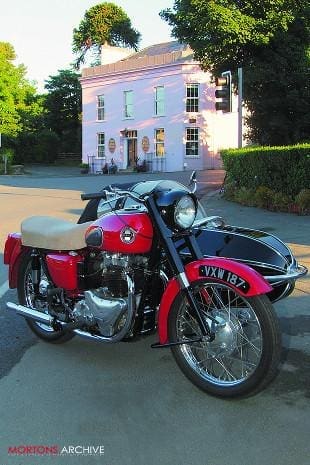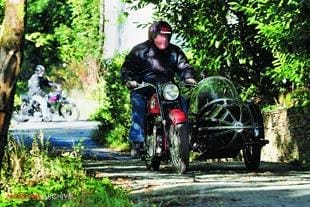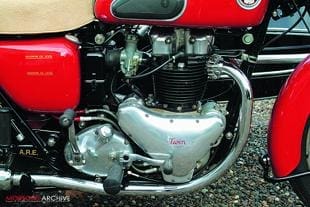Unsurprisingly, Tony East’s stunning Huntmaster outfit is a hit with the children. Grandchildren, neighbour’s offspring, friend’s siblings and almost every child who sees the outfit beams. Aged seven when this twin left Ariel’s Selly Oak factory, I’d have taken no prisoners to guarantee first go in the Garrard GP’s dickie seat while older female cousins would have smugly claimed the front pew.
First registered in London during September 1958, the 650 parallel twin Huntmaster makes this combination the perfect plot for children but how about us grown-ups? Here comes my problem as a tester. Months after our test I’m still so bowled over by this glamour outfit – clearly I’m just a big child – that I’ve needed to take myself in hand to write objectively. And all of this emotion is all the more surprising as, although I long ago mastered the art of driving outfits, usually they’re not my cup of tea.
 In common with many of the machines Tony owns and displays in his motorcycle museum at The Old Vicarage, Kirk Michael, Isle of Man (which is open on many Sunday afternoons in aid of The Friends of the TTRA) the Huntmaster had the full ‘East’ treatment.
In common with many of the machines Tony owns and displays in his motorcycle museum at The Old Vicarage, Kirk Michael, Isle of Man (which is open on many Sunday afternoons in aid of The Friends of the TTRA) the Huntmaster had the full ‘East’ treatment.
Work on all Tony’s bikes usually begins with a visual examination to check originality and compare with period literature. Decisions are made as to what are acceptable variations involving period accessories and what aren’t. As machines are stripped, a report is compiled and major units readied for refurbishment, either under the control of Tony’s system or using acknowledged specialists for wheel building, plating etc.
Regardless of assumed value or age, each East motorcycle is restored to the same exacting standard, which in most cases is as the maker built it. Many of Tony’s motorcycles would please concours judges but no attempt is made to over ‘bull’ them up. As we know, the paintwork and plating applied today is often of a higher standard than may have been expected from Greeves, BSA, Norton et al in period.
This Ariel twin was restored while Tony still lived near Farnham, Surrey, where he ran his motor factor and motorcycle bench businesses. After appropriate specialist work was completed, refurbished and rebuilt parts returned to Tony’s base to join work undertaken in house and the motorcycle was assembled. Similar processes now happen in the IoM.
 While Tony was – and still is – directly involved with each rebuild, he long ago accepted that with the number of motorcycles he’s collected he can’t undertake all the work himself. Likewise the thought of taking years over a restoration has no place in Mr East’s mind. To help the process along, Tony had help while based in England and has enlisted a similar, restoration team now he’s retired.
While Tony was – and still is – directly involved with each rebuild, he long ago accepted that with the number of motorcycles he’s collected he can’t undertake all the work himself. Likewise the thought of taking years over a restoration has no place in Mr East’s mind. To help the process along, Tony had help while based in England and has enlisted a similar, restoration team now he’s retired.
Restoration is, for many of us, a compulsive pursuit and with a collection of 60-plus motorcycles it would be all too easy for Tony to push those completed a few years ago or the less favoured machines to the back of the workshop, garage or museum, where tyres would deflate, oils absorb moisture and dust would build. Instead, each machine, even if not on the road, is removed from the museum and given a regular ‘brush up’. Work not only includes cleaning but a service and run too. And with an extensive garden and orchard it’s not too hard to cover a few miles legally without venturing onto the public roads. Sensibly, machines that are no longer wanted are sold.
When I enjoyed a few days with Tony and his partner Pat last autumn Mr East made the dangerous – I thought – claim that whatever motorcycles I chose to try he’d get running. Even if the machine I chose was unlicensed I’d be able to take it for a for a blast up and down the Old Vicarage’s tracks and paths. Apart from a factory-fresh model which hadn’t been fully completed Tony’s pledge proved right. Indeed, in the past it took the full effort of a film crew to shake Tony’s claim and then only temporarily – when they returned a well-sorted scooter as a non-runner.
With the Huntma ster warmed and ready, Tony headed off to Ballacraine, I followed on another motorcycle. The chance to spend a few days in the IoM away from race or practice weeks offered me the opportunity to visit TT landmarks, study racing lines, look at the escape routes and, thanks to the loan of some superb motorcycles, try the bends, bridges and climbs – albeit at a rather more sedate pace than TT competitors.
ster warmed and ready, Tony headed off to Ballacraine, I followed on another motorcycle. The chance to spend a few days in the IoM away from race or practice weeks offered me the opportunity to visit TT landmarks, study racing lines, look at the escape routes and, thanks to the loan of some superb motorcycles, try the bends, bridges and climbs – albeit at a rather more sedate pace than TT competitors.
From the earliest days almost 100 years ago, press photographers sited themselves at Ballacraine for the medium-speed right-hander, after which riders headed for the tricky Ballig and Glen Helen sections. Brave riders all, exemplified by Billy (WF) Newsome – Triumph, Oliver Godfrey – Indian, EB Ware – Zenith (all renowned Brooklands runners) and many more who were captured for ever on glass plate, sliding foot down through the dust in the days before WWI. Straightening the plot by the side wall of the former Ballacraine Hotel they would be ready to open the taps for Ballig.
Despite traffic lights, school buses trundling to St Johns and the seemingly endless stream of builders’ trucks, the Huntmaster looked at home on location at Ballacraine. At these near mystic locations it is all too easy to blur the decades in one’s mind switching instantly from sliding belt drivers, to Bob McIntyre’s drifting Gilera, to whatever and back to the present and the Huntmaster in a trice. And it was on such outfits smart young couples may have crossed from Liverpool for a week watching the racing. Billeted in Douglas, Ramsey or wherever, the outfit would have been perfect – and stylish – Island transport complete, one hopes, with an ample picnic hamper.
Imaginary sporting couples
A couple of years later, our imaginary sporting couples may have had a nipper. No worries. Garrard’s stunning alternative to the bulky box-like child/adult sidecar many family couples favoured, could cope. With its bullet-like lines, monocoque construction and decent trailing-arm suspension, the London makers had their trendsetting sidecar near perfect. Perfect that is – except for their timing.
Unfortunately Alec Issigonis’ front wheel drive Mini, initially tagged with minimal imagination as the Austin Seven or Morris Mini Minor, was launched. Despite the maker’s pedestrian marketing jargon – even for the standards of the late 1950s – the Mini, with 10in wheels and rubber suspension courtesy of Alec Moulton did it for our fictitious dashing young couple – and in fact almost all Mr, Mrs and Miss Everyone aged seven months to 107 years. Suddenly the dashing Garrard Grand Prix child/adult sidecar was obsolete. As a result survivors are rare, so despite not being a sidecarist, I wasn’t missing out.
 I can’t speak for other testers but for me the first mile or two on another’s pride and joy sets emotions into turmoil. Stress and blood pressure rise as inner confidence plummets. The need to achieve clean gearchanges and smooth braking instantly are paramount. Other concerns include what other road-users are up to and our collective safety, set against producing a best job for the magazine. All worrying on a solo, but with an outfit of which I understand little of set-up (while terms such as toe-in, trail and lean-out come from another world), inner turmoil can only mount.
I can’t speak for other testers but for me the first mile or two on another’s pride and joy sets emotions into turmoil. Stress and blood pressure rise as inner confidence plummets. The need to achieve clean gearchanges and smooth braking instantly are paramount. Other concerns include what other road-users are up to and our collective safety, set against producing a best job for the magazine. All worrying on a solo, but with an outfit of which I understand little of set-up (while terms such as toe-in, trail and lean-out come from another world), inner turmoil can only mount.
Just 200 yards, one bend and an application of the brakes restored inner calm. While I could never hope to set up an outfit well, I respect those who can and appreciate a well-sorted plot. And, along with a BSA A10 Watsonian I enjoyed the summer before last, Tony’s combination of Huntmaster and Garrard is tops. Within a mile I’d caught Tony’s much older but by no means slow Triumph on a twisty IoM back road I’d never seen before.
Little on the slow side
On left-handers, my approach was a little on the slow side, then power on; while for right-handers enter fast and brake. Experts may feather brakes and power but this simple approach suits me and suited the Huntmaster outfit. So if a combination works well on bends how can it remain in a straight line under hard braking? I’ve no idea but this one does. And they should. No Herculean efforts or death-defying exploits to record here.
Sharing the same bore and stroke dimensions as my favoured standard model BSA A10s, the Huntmaster is from, I vow, the same mould.
As that great British motorcycle designer Val Page was finishing his drawings for Ariel’s first parallel twin behind the scenes, control of the Selly Oak factory – well at least financial control – was passing across Birmingham to Small Heath and the BSA Group. And beneath all these undercover shenanigans lies the likelihood of even more cloak and dagger intrigue.
Val Page’s Triumph 6/1 para llel twin was unveiled in 1933, a handful of years before Edward Turner smartly worked the concept into his 500 Speed Twin, the sporting Tiger 100. After Triumph, Val Page beavered away at BSA rationalising the complex Small Heath range and developing the M series, including the much-loved M20 side-valve and first Gold Star, the M24. And we all know what that led to.
llel twin was unveiled in 1933, a handful of years before Edward Turner smartly worked the concept into his 500 Speed Twin, the sporting Tiger 100. After Triumph, Val Page beavered away at BSA rationalising the complex Small Heath range and developing the M series, including the much-loved M20 side-valve and first Gold Star, the M24. And we all know what that led to.
It’s obvious BSA was caught napping by the success and style of the Turner twin from Coventry, leading them to work on a vertical twin before WWII stopped such efforts. Occasional Small Heath visitors reported glimpsing fast-accelerating motorcycles that appeared to be of parallel twin design returning rapidly through the factory gates after tests to be stealthily spirited away behind closed doors.
By 1939, Page was back at Ariel and his first effort post-WWII vertical twin for Selly Oak bore such a close resemblance to the post-war production BSA twin, it’s difficult to believe they weren’t extremely closely related by design if not management. One wonders – well I do at least – had Mr Page sketched the twin design for BSA before he departed in those dark days leading up to WWII? True, Perkins and later Hopwood re-worked the concept for BSA after the war, true the twin-cylinder concept evolved at Ariel too and true both makers shared financial interests and production-line economies, but ride them both and its impossible to believe they didn’t initially come from the same pen.
Out on the road, the Huntmaster shows its true colours instantly, with an easy delivery of ample power for every occasion our classic motorcycles may encounter. Added to that are well thought-out touring gear ratios and an upright riding position which suits most of us.
While parallel twins may be revved, it’s a sin to slog them. However, most give you a feel as to what suits and what doesn’t. Suitably chastised, you’ll soon learn! On this sidecar example with lowered gearing, upward changes at 12, 25 and 35mph suited the brisk acceleration needed on today’s roads but kept the motor happy too. On the flat, the plot pulled away from the high 20s in top without any signs of distress – but any lower and the rider would soon know.
revved, it’s a sin to slog them. However, most give you a feel as to what suits and what doesn’t. Suitably chastised, you’ll soon learn! On this sidecar example with lowered gearing, upward changes at 12, 25 and 35mph suited the brisk acceleration needed on today’s roads but kept the motor happy too. On the flat, the plot pulled away from the high 20s in top without any signs of distress – but any lower and the rider would soon know.
Burman gearboxes of the 1950s never offered the quickest change on the block, especially compared with BSA and Triumph boxes, but this Huntmaster was the exception. While ultra-quick changes were rewarded with a light crunch, normal touring-style gear swaps, even rapid ones up or down were smooth and silent. And although neutral is usually best selected while rolling to a halt, it took no effort to find neutral once stopped.
Past experience informs that Huntmaster handling and steering is almost identical to that of their cousins from Small Heath. Safe, precise steering without being racer-sharp, rock steady in a straight line and appropriate lean ensures perfect curves round bends. Without any work to alter the steering head angle, Tony’s Ariel twin follows the same reassuring traits despite having gained a third wheel and modest weight addition.
Seat height and comfort along with footpeg and handlebar position suited my six-foot frame. Mr East – who’s my height but of sturdier build – also finds the Huntmaster ‘perfectly comfortable’. With long legs I can easily place both feet flat on the ground with inches to spare but boasting a 31in seat height those with very short legs will struggle to paddle the big Ariel twin about solo. However attached to this delightful sidecar few would be challenged.
 As many have experienced, Isle of Man lanes are not only steep but have unexpected semi-concealed sharp turns. And worse… what goes up must come down, which can be worrying. Although satisfied the brakes pulled up in a straight line, uncertainties about their capabilities with 600-plus pounds of motorcycle and sidecar saddled with the best part of 200lb of me on steep declines restarted my inner turmoil. And following Tony along his favourite roads, I didn’t have to wait long before giving them a real test. Adequate rather than brilliant sums up their capability but at least the turmoil subsided again.
As many have experienced, Isle of Man lanes are not only steep but have unexpected semi-concealed sharp turns. And worse… what goes up must come down, which can be worrying. Although satisfied the brakes pulled up in a straight line, uncertainties about their capabilities with 600-plus pounds of motorcycle and sidecar saddled with the best part of 200lb of me on steep declines restarted my inner turmoil. And following Tony along his favourite roads, I didn’t have to wait long before giving them a real test. Adequate rather than brilliant sums up their capability but at least the turmoil subsided again.
Photographer satisfied, it was down to me to return the Ariel to base while the others did their own thing. Once I’d rejoined the twisty main roads which form part of the TT course, the combination came into its own. It settled at a steady gait of around 55-60mph, seemingly of its own accord with just a touch of power or brakes to ease it through the twists and turns as appropriate. Down to the 30mph for each town and village and once clear, and without need to drop a cog the plot was up to its own cruising speed in literally a jiffy. Like those favourite carpet slippers, the Huntmaster takes care of its riders.
Reminded of the old overused cliche ‘it was over all too soon’ I found myself back at Kirk Michael and the Old Vicarage gates. Tempted to blast by for one more ride over Ballaugh Bridge, then Sulby and perhaps into Ramsey I reined myself in, as the 3pm Seacat for Liverpool beckoned. Happy and sad, I rumbled down Pat and Tony’s stone drive and parked the warm friendly outfit in its home, ready for another day and another rider. Smitten? Without doubt.



